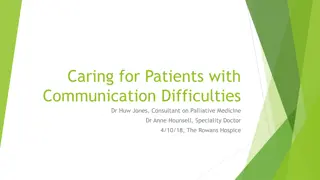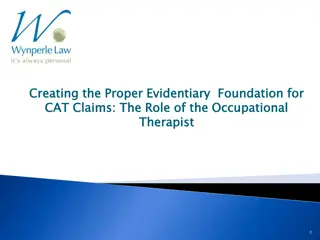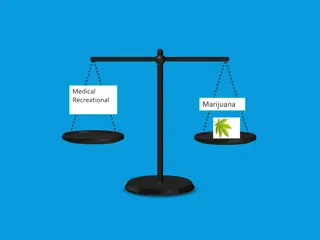Marijuana Impairment and Driving: Challenges for Education and Enforcement
The content discusses the challenges related to marijuana impairment and driving, particularly focusing on the legalization of medical and recreational marijuana in Michigan. It goes over the current laws in Michigan, vocabulary related to marijuana, and the impact of cannabis on driving abilities based on studies. It highlights how cannabis affects critical driving skills, such as reaction time, judgment, and coordination, and compares the driving behaviors of cannabis-impaired drivers to alcohol-impaired drivers.
Download Presentation

Please find below an Image/Link to download the presentation.
The content on the website is provided AS IS for your information and personal use only. It may not be sold, licensed, or shared on other websites without obtaining consent from the author.If you encounter any issues during the download, it is possible that the publisher has removed the file from their server.
You are allowed to download the files provided on this website for personal or commercial use, subject to the condition that they are used lawfully. All files are the property of their respective owners.
The content on the website is provided AS IS for your information and personal use only. It may not be sold, licensed, or shared on other websites without obtaining consent from the author.
E N D
Presentation Transcript
Marijuana Impairment and Driving: Challenges for Education and Enforcement Carol Flannagan, Ph.D. University of Michigan Transportation Research Institute March 20, 2019
Marijuana in Michigan Medical marijuana was legalized in 2008 (Michigan Medical Marihuana Act, or MMMA) Recreational marijuana was legalized in 2018 (Michigan Regulation and Taxation of Marihuana Act, or MRTMA; took effect Dec. 6, 2018)
Marijuana in Michigan Current law requires demonstration of impairment due to marijuana ingestion to charge a driver with drugged driving Zero tolerance policy for non-medical-marijuana users means any marijuana equals drugged driving, but this may change
Vocabulary Marijuana = Marihuana -> common term for parts of the cannabis sativa plant Cannabis -> technical term for marijuana 9-tetrahydrocannabinol ( 9-THC) -> The primary psychoactive compound in marijuana & the primary compound measured in blood (but not the only one)
Does cannabis impair driving? In controlled laboratory, simulator and driving studies*, 9-THC: Affects areas of the brain that control movement, balance, coordination, memory, and judgment Impairs critical driving-related skills including reaction time, tracking ability, target detection, judgment, anticipation, divided attention, route planning and risk taking *Hartman, R. L., & Huestis, M. A. (2013). Cannabis effects on driving skills. Clinical chemistry, 59(3), 478-492
Does cannabis impair driving? Cannabis-impaired subjects typically drive slower, keep greater following distances, and take fewer risks* Alcohol-impaired subjects generally drive faster and take more risks when drunk However, cannabis-impaired drivers do not fully mitigate the effects of the drug on driving skills, and acute cannabis intoxication can result in more risk taking rather than risk compensation. *Compton, R. P. (2017). Marijuana-impaired driving-a report to congress (No. DOT HS 812 440). United States. National Highway Traffic Safety Administration.
Does cannabis cause crashes? National Academy of Sciences concluded that there is substantial evidence of a statistical association between cannabis use and increased risk of motor vehicle crashes * Estimated the increased risk at 22% - 36% A case-control study found that when concurrent alcohol and driver demographics were taken into account, the cannabis-specific risk goes away* This may result from the low-severity crashes in the sample and not considering THC level in the analysis *Compton, R. P. (2017). Marijuana-impaired driving-a report to congress (No. DOT HS 812 440). United States. National Highway Traffic Safety Administration.
Does cannabis cause crashes? Yes, but the specific risk increase isn t nailed down The risk for cannabis is less than alcohol But drivers positive for 9-THC are often also positive for alcohol This is called polydrug impairment and is a growing problem (more on this later)
Per se limits Per se limits for Blood Alcohol Content (BAC) have been very successful in creating a clear definition of drunk driving and BAC- based laws have helped to reduce drunk driving worldwide This is the 0.08 level, above which the driver is impaired per se This approach is desirable for cannabis Several states have set limits ranging from 1 ng/ml-5 ng/ml
Per se limits Per se limits for Blood Alcohol Content (BAC) have been very successful in creating a clear definition of drunk driving and BAC- based laws have helped to reduce drunk driving worldwide This is the 0.08 level, above which the driver is impaired per se This approach is desirable for cannabis Several states have set limits ranging from 1 ng/ml-5 ng/ml Remember these numbers
Blood levels of 9-THC Graph from: Compton, R. P. (2017). Marijuana-impaired driving-a report to congress (No. DOT HS 812 440). United States. National Highway Traffic Safety Administration.
Blood levels of 9-THC Initial rapid elimination phase blood levels peak very quickly Graph from: Compton, R. P. (2017). Marijuana-impaired driving-a report to congress (No. DOT HS 812 440). United States. National Highway Traffic Safety Administration.
Blood levels of 9-THC Long terminal elimination phase blood levels fade away very slowly Graph from: Compton, R. P. (2017). Marijuana-impaired driving-a report to congress (No. DOT HS 812 440). United States. National Highway Traffic Safety Administration.
Blood levels of 9-THC In chronic users, this tail can last for weeks even after quitting Graph from: Compton, R. P. (2017). Marijuana-impaired driving-a report to congress (No. DOT HS 812 440). United States. National Highway Traffic Safety Administration.
Blood levels of 9-THC It often takes 2 hours to get to drawing a blood sample after a traffic stop Graph from: Compton, R. P. (2017). Marijuana-impaired driving-a report to congress (No. DOT HS 812 440). United States. National Highway Traffic Safety Administration.
Blood levels of 9-THC 100 Blood 9-THC (ng/ml) Percent of Baseline 80 60 40 20 Graph from: Compton, R. P. (2017). Marijuana-impaired driving-a report to congress (No. DOT HS 812 440). United States. National Highway Traffic Safety Administration.
Blood levels of 9-THC 100 Blood 9-THC (ng/ml) Percent of Baseline 80 60 40 Worst performance at 90 mins 20 Graph from: Compton, R. P. (2017). Marijuana-impaired driving-a report to congress (No. DOT HS 812 440). United States. National Highway Traffic Safety Administration.
Blood levels of 9-THC Peak blood levels at 15- 30 mins 100 Blood 9-THC (ng/ml) Percent of Baseline 80 60 40 20 Graph from: Compton, R. P. (2017). Marijuana-impaired driving-a report to congress (No. DOT HS 812 440). United States. National Highway Traffic Safety Administration.
Blood levels of 9-THC 100 Blood 9-THC (ng/ml) Percent of Baseline 80 60 40 ~5 ng/ml (Did you remember the numbers???) 20 Graph from: Compton, R. P. (2017). Marijuana-impaired driving-a report to congress (No. DOT HS 812 440). United States. National Highway Traffic Safety Administration.
What does this mean? Lack of correspondence between blood 9-THC and impairment This requires particular emphasis on detecting (and documenting) impairment Enter: Standardized Field Sobriety Tests (SFSTs)
Role of SFSTs Standardized Field Sobriety Tests (SFSTs): Many field tests have been studied for relationship to impairment Three specific tests are scientifically validated on alcohol impairment and are generally admissible in court: 1. Horizontal gaze nystagmus (HGN): The subject is instructed to follow the movement of a light (or finger or other object) with only the eyes and no head movement; impaired subjects cannot follow the movement smoothly and a distinct jerk will appear prior to 45 . 2. Walk-and-turn test (WAT): The subject must walk nine heel-to-toe steps on a line, turn, and return along the line with nine heel-to-toe steps. 3. One-leg stand (OLS): The subject must raise one leg and hold it ~6 inches up while counting slowly until told to stop (at 30 sec.).
Role of SFSTs More recent studies have looked at SFSTs and marijuana impairment Papafotiou, K., Carter, J. D., & Stough, C. (2005). An evaluation of the sensitivity of the Standardised Field Sobriety Tests (SFSTs) to detect impairment due to marijuana intoxication. Psychopharmacology, 180(1), 107-114
Role of SFSTs SFSTs do correspond to cannabis-impaired driving, but not as well as for alcohol In the field, SFSTs are only administered when other evidence of impaired driving is observed The study authors note that in combination with observations of impaired driving behavior, the SFSTs also identify cannabis impairment well enough Alcohol is often present in cannabis-impaired drivers, making SFSTs more likely to be effective tools for determining impairment Papafotiou, K., Carter, J. D., & Stough, C. (2005). An evaluation of the sensitivity of the Standardised Field Sobriety Tests (SFSTs) to detect impairment due to marijuana intoxication. Psychopharmacology, 180(1), 107-114
Role of SFSTs But more research is needed! Need to consider additional SFSTs to be validated specifically for cannabis impairment
Polydrug Impairment Drivers who test positive for 9-THC are more often also positive for alcohol or other drugs than 9-THC-negative drivers In a 2013 roadside survey, during the day, drug-positive drivers were over three times as likely to have BAC 0.08 compared to the average driver (1.4% vs. 0.4%) At night, drug positive drivers were slightly more likely to have BAC 0.08 than the average driver (1.7% vs. 1.5%)
Trends in Michigan: Drug-Involved Crashes Graph shows all drug- involved crashes Cannabinoids are 70% of drug-positive tests
Trends in Michigan Of the 540 drivers who tested positive for cannabinoids and also had alcohol tests, 44% had been drinking before driving (i.e., had non-zero BAC) and 11% were over the 0.08 BAC limit In Michigan (and many other states), drug tests are typically not done if BAC 0.10 This makes it difficult to get an accurate estimate of polydrug use Polydrug use is likely higher than estimated
What can we do? Enforcement Oral fluids study conducted in four counties showed promising results with correspondence between oral and blood results Oral fluids have the advantage of being sensitive to recent use (even of edibles) Oral fluid testing can be done at roadside, avoiding delays when blood levels drop Report available at: https://www.michigan.gov/documents/msp/Oral_Fluid_Report_646833_7.pdf
What can we do? Enforcement Greater training for officers in recognizing signs of cannabis- impairment Broader Advanced Roadside Impaired Driving Enforcement (ARIDE) training Expansion of the Drug Recognition Expert (DRE) program
ARIDE ARIDE training is intended to bridge the gap between the SFST and DEC/DRE programs by providing officers with general knowledge related to drug impairment 16-hour training course taught by DRE instructors Sessions include: 1. Introduction and Overview of Drugs and Highway Safety 2. SFST Update, Review and Proficiency Examination 3. Observations of Eyes and other Sobriety Tests to Detect Alcohol and Drug Impairment 4. Seven Drug Categories 5. Effects of Drug Combinations 6. Pre- and Post-Arrest Procedures
Drug Recognition Experts (DRE) DREs undergo substantial training (2-3 weeks of intensive classroom and practical work) A DRE conducts a detailed, diagnostic examination of persons arrested or suspected of drug-impaired driving or similar offenses. Based on the results of the drug evaluation, the DRE forms an expert opinion on the following: 1. Is the person impaired? If so, is the person able to operate a vehicle safely? If the DRE concludes that the person is impaired 2. Is the impairment due to an injury, illness or other medical complication, or is it drug-related? If the impairment is due to drugs 3. Which category or combination of categories of drugs is the most likely source of the impairment?
Drug Recognition Experts (DRE) While ARIDE training is meant for all officers, DREs are a small subset Ideally, DREs are deployed around the state and can be called in to evaluate as needed
What can we do? Education Public misconceptions about the safety of cannabis-impaired driving are common According to a GHSA report: In surveys and focus groups with regular marijuana users in Colorado and Washington, almost all believed that marijuana doesn t impair their driving, and some believed that marijuana improves their driving Most regular marijuana users surveyed in Colorado and Washington drove high on a regular basis. They believe it is safer to drive after using marijuana than after drinking alcohol. They believe that they have developed a tolerance for marijuana effects and can compensate for any effects, for instance by driving more slowly or by allowing greater headways.
What can we do? Education Educational campaigns are being developed in many states, especially those with recreational marijuana Campaigns that engage the dispensary industry in helping get the message out are thought to be more effective
What can we do? Education According to GHSA, drivers need to understand: 1. That marijuana can impair driving 2. That driving while impaired by marijuana is illegal
What can we do? Research Research is needed in several areas: 1. Oral fluids and other biological tests of the presence and impairing levels of 9-THC in the body 2. SFSTs (i.e., behavioral tests) that are most diagnostic of 9-THC impairment 3. Effects of polydrug impairment, especially involving alcohol and cannabis (or other drugs), on driving
Thank you! (Questions?)























